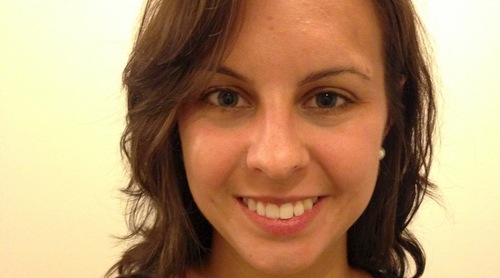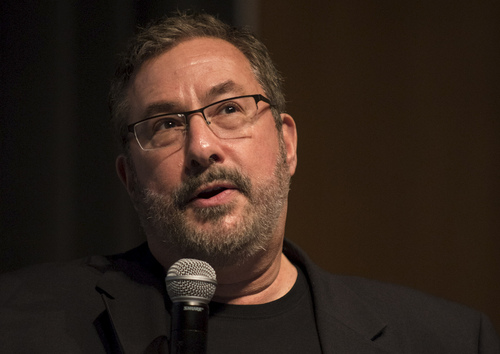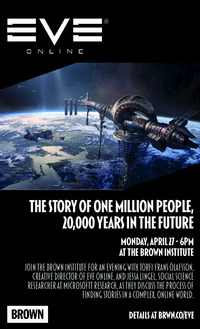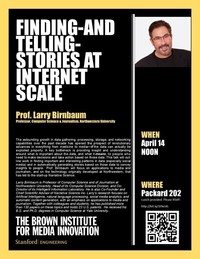2014-2015 Magic Grantees Jessa Lingel and Adam Golub have just published a paper from the Bushwig project. "In Face on Facebook: Brooklyn's Drag Community and Sociotechnical Practices of Online Communication" appears in the June issue of The Journal of Computer-Mediated Communication, and is likely the first paper published on how drag performers use social media. Here is their abstract.
Recently, Brooklyn has seen an explosion of drag culture, with dozens of performers taking the stage in any given week. Social media plays a vital role for members of this community, simultaneously allowing self-promotion and community solidarity. Drawing on focus group interviews, we analyze the communication practices of Brooklyn's drag performers, examining both the advantages and drawbacks of social media platforms. Using conceptual frameworks of faceted identity and relational labor, our discussion focuses on affordances and constraints of multifaceted identity in online contexts and theories of seamful design. We contend that by analyzing online communication practices of drag performers, it becomes possible to identify gaps between embedded ideologies of mainstream social media technologies and the localized values of outsider communities.
The full article is available from the journal site (you might need a subscription to view the articles in this journal). Congratulations to Jessa and Adam!

The Brown Institute, in collaboration with the du Pont Awards and the Online News Association, presented a panel on reporting using virtual reality (VR). VR offers journalists the ability to immerse viewers, transporting them to new places and situations. How are these technologies being applied? How are stories being told? What devices help create narratives? Is narrative even necessary? Prior to the panel, attendees experimented with various VR headsets to get a sense the potential of VR.

The panelists included Raney Aronson, FRONTLINE's Deputy Executive Producer (@raneyaronson), Fergus Pitt, senior fellow The Tow Center for Digital Journalism at Columbia University (@fergle), Joao Inada, team member of our own Magic Grant VR project "Reframe Iran," and Gabo Arora, UN Senior Advisor, producer "Clouds Over Sidra" (@gaboarora). The panel was moderated by duPont's Lisa Cohen. The panelists had experience producing VR documentaries, wrestling with issues about their placement in the frame ("Do you just leave the camera in the middle of the street and hide or are you in the shot?"), about how to provide viewers context for what they are seeing ("Is this a typical town in this part of Africa or has something bad happened here?") and how story emerges ("What happens if a viewer is looking in the other direction when something significant happens?"). This is our first partnership with du Pont and ONA and we're eager to explore more connections!
Brown Advisory Board Member and partner at Kleiner Perkins Caufield & Beyers, Mary Meeker, just released her 2015 Internet Trends report. Meeker has been publishing these reports since 2001, and TechCrunch calls them "the closest thing you'll get to gospel." You can read the full 197 page report, or the highlights edited by TechCrunch.

Each year the Brown Institute and the Tow Center team up on a award for the Columbia J-School graduate whose thesis makes extensive use of computation, or in some way pushes the boundary of storytelling through a novel application of technology. This year the award went to Ariana Giorgi, a Dual Degree student receiving both her M.S. in Journalism and Computer Science. Her Master's project applied techniques she studied in her machine learning and natural language processing courses to partially automate the collection and organization of large quantites of data assembled from different sources. Her main focus was on the tradeoff between manual processing and automated or algorithmic techniques. The Brown/Tow Award comes with a $2000 prize. Congratulations Ariana!
This month's Communications of the ACM includes "Putting the Data Science into Journalism." Our flagship project Science Surveyor is detailed as an example of journalistic technology, and the Lede Program is singled out as a new kind of journalism training! The article also contains some great quotes from attendees of the Computation+Journalism meeting we help sponsor. Read the full article.
We are pleased to announce our 2015-16 “Magic Grants” - eight teams in all, comprised of students, faculty, alumni and post-docs from the Columbia Journalism School and the Stanford Engineering School. This year’s Magic Grant recipients were selected via a competitive process from nearly 50 proposals. Each project speaks directly to our mission - supporting new endeavors that inform and entertain in transformative ways.
The 2015-16 Magic Grant evaluation process included incoming West Coast Director, Maneesh Agrawala, who will pick up the reins from current director Bernd Girod. "We are very excited that Maneesh will be joining us as a faculty colleague at Stanford,” said Girod. “Together with East Coast Director Mark Hansen, Maneesh will take the Brown Institute to the next level.”
“With this group of Magic Grants, we have timely, powerful stories and incredibly novel uses of technology,” Hansen said.
This year’s winning projects include an interactive personal drone tour guide; a documentary filmed with immersive video technology, that maps the impact of the famine in South Sudan; and a “bicoastal” project that will allow journalists to analyze, visualize and interact with contractor data released by the Department of Defense. Individual Magic Grants can be up to $150,000, with funding reaching up to $300,000 for bicoastal projects, those having teams with members from both universities’ communities.
The Brown Institute is also, for the first time, providing funding for a so-called “flagship project.” A flagship project is a continuation of a particularly promising Magic Grant that can receive up to $500,000 for the following year. These special projects must be bicoastal, with substantial work carried out at both the Stanford School of Engineering and the Columbia Graduate School of Journalism. Application for flagship status is by invitation only. This year’s flagship project is the Science Surveyor.
Science Surveyor (Bicoastal, Columbia and Stanford): One of the biggest challenges facing science journalists is the ability to quickly contextualize journal articles they are reporting on deadline. Science Surveyor is a tool that can help science journalists and others rapidly and effectively characterize the scientific literature for any topic by providing a contextual consensus, a timeline of publications surrounding the topic, and categorized funding. The Science Surveyor team consists of Marguerite Holloway, Laura Kurgan, Dennis Tenen, Juan Francisco Saldarriaga, Daniel McFarland, Dan Jurafsky and Sebastian Muñoz Najar Galvez.
Following is a complete list of the Magic Grants for 2015-16:
Art++ (Stanford): Meaning Augmenting Art with Technology, Art++ aims to improve the experience of visitors in a museum gallery by proposing a new way of delivering information to them. Using augmented reality, Art++ offers viewers an immersive and interactive learning experience by overlaying content directly on the objects through the viewfinder of a smartphone or tablet device. The Art++ team is being funded for a second year, and consists of Maricarmen Barrios, JeanBaptiste Boin and Jacqueline Lin.
Cuba Interconectada (Columbia): After decades of Castro control, change is coming to Cuba. The prospect of closer ties with the United States, and with that a greater access to the Internet, promises a revolution in a nascent community of local entrepreneurs. Cuba Interconectada will tell a story about change on the island by focusing on Cuban entrepreneurs; the way access to the Internet currently exists; and changes as the Cuban economy opens. The Cuba Interconectada team consists of Juanita Ceballos, Jika González and Dave Mayers.
G:Drone – An Interactive Personal Drone Tour Guide (Stanford): Currently, drones are used primarily for filming, farming, search and rescue, entertainment, and product delivery. The team will explore human-drone interaction through the use of drones as tour guides. This is a challenging research topic as it encompasses fields such as proxemics, the distance between the drone and the person or the group (social sciences), calculating the best path for the drone (computer vision), how users communicate with the drone (HCI), how the drone responds to users (HCI), and having the drone take pictures or movies of the visitors (computer vision). The G:Drone team is comprised of Dr. Jessica Cauchard and Jane E.
Generating Emotional Impact in Narrative (Stanford): We respond to stories not only because of the information they contain, but also because of the emotional impact. Creating emotional impact is challenging, but professionals know that there is a process, though hard to articulate at a level that novices can follow. The team will decompose the act of creating emotional impact into a process that novices can follow on a website in under five minutes. Eventually, the novices will perform as well as experts. This team is headed by Lydia Chilton.
Nueva Nacion (Columbia): Currently, no Panamanian media outlet has a serious data analysis team. Stories are often told without appealing to data and the context they might provide. Panama is one of the fastest growing economies in Latin America, but it also suffers from a large socio-economic gap and has a high corruption index according to Transparency International. Nueva Nacion will explore the government’s untapped numbers, giving way to many new and unexplored stories that would benefit the country, and possibly the region. The team consists of Ana Méndez, Alfonso Poschl and Gaspar García de Paredes.
open.contractors (Bicoastal, Columbia and Stanford): Modern reporting increasingly relies on using data as source of evidence—numbers on a page can prove trends and anomalies and add context to anecdotes told by sources. Fortunately, many government agencies release data openly on the web, but unfortunately much of this data is presented in a frustrating and byzantine manner. open.contractors, an open-source web dashboard that will allow journalists to easily analyze, visualize and interact with contractor data from the Department of Defense. The open.contractors team is comprised of Alexandre Gonçalves and Allison McCartney.
Recipe for a Famine (Columbia): The United Nations warns that 2.5 million people are on the brink of famine in South Sudan. An ongoing civil war, extreme poverty and international apathy are creating a man-made catastrophe that we are witnessing in real time. Recipe for a Famine is an immersive documentary that explores the causes of famine and its human impact. In addition to the documentary, the team will create a VR 101 Toolkit to make high quality immersive video more accessible to more journalists. The team consists of Marcelle Hopkins, Benedict Moran, Evan Wexler and Andrew Blum, and is funded by the Brown Institute, and the PBS series FRONTLINE. The team was also awarded a Social Justice fellowship from the Made in NY Media Center by IFP.

RSVP Here
Storytelling is essential for communicating ideas. When they are well told, stories help us make sense of information, appreciate cultural or societal differences, and imagine living in entirely different worlds. Audio/visual stories in the form of radio programs, audiobooks, podcasts, television, movies or animation are especially powerful by providing a rich multisensory experience. Technological advances have made it easy to capture stories using microphones and cameras readily available in our mobile devices. The raw media, however, rarely tells a compelling story.
The best storytellers carefully compose, filter, edit and highlight raw media to produce an engaging piece. Yet, the software tools they employ (e.g. Pro Tools, Premiere, Final Cut Pro, Maya, etc.) force tediously low-level work—selecting, filtering, cutting and transitioning between audio/video frames. While these provide flexible and precise control over the look and sound of the final result, they are notoriously difficult to learn and accessible primarily to experts. In this talk, Prof. Agrawala will present recent projects that aim to significantly reduce the effort required to edit and produce high-quality audio/visual stories.
Maneesh Agrawala is a Professor of Electrical Engineering and Computer Science at the University of California, Berkeley. He works on visualization, computer graphics and human computer interaction. His focus is on investigating how cognitive design principles can be used to improve the effectiveness of visual displays. The goals of this work are to discover the design principles and then instantiate them in both interactive and automated design tools. He received an Okawa Foundation Research Grant in 2006, an Alfred P. Sloan Foundation Fellowship and an NSF CAREER Award in 2007, a SIGGRAPH Significant New Researcher Award in 2008, and a MacArthur Foundation Fellowship in 2009. He will assume directorship of the Brown Institute of Media Innovation at Stanford in Fall 2015.
The Brown Institute, in conjunction with Magnum Foundation, is pleased to announce Photography, Expanded, weeks of events focused on the intersection of photography, digital narrative and journalism. The events, along with brief descriptions, can be seen below:
Photojournalist Maria Turchenkova - Reception honoring her as the 2015 Paul Klebnikov Russian Civil Society Fellow
6PM, Monday, April 15 at the Brown Institute
Details at http://brwn.co/photo-x1
Signs of Faith: Bridging Cultures through the Power of Image
7PM, Wednesday, April 22 at the Brown Institute
Panel discussion with Alysia Steele, author of “Delta Jewels,” and Chie Nishio, photographer of Brooklyn’s Lubavitch Community
Details at http://brwn.co/photo-x2
Photography, Expanded Panel: Digital Interventions
6PM, Tuesday, April 28 at Aperture Gallery
A panel featuring Lance Weiler, Lina Srivastava, Jonathan Harris and Christopher Allen, exploring how image-based interventions inform, activate, and strengthen communities, not only on social media, but also in the physical world.
Details/RSVP at http://brwn.co/photo-x3
Tow Tea: Curating Digital Photography
4PM, Thursday, April 30 at the Brown Institute
Join Susan Meiselas, Magnum photographer and President of Magnum Foundation, and Yukiko Yamagata, Associate Director of Open Society Foundations Documentary Photography Project as they discuss the intricacies and issues that arise when curating digital photography. In this era where our screens and our psyches are saturated by images, can photographic narratives on social justice issues still elicit an emotional response from a viewer? What is the role of documentary photography in this new, saturated digital landscape?
Details/RSVP at http:/brwn.co/photo-x5
Photography, Expanded Lab
Saturday-Sunday, May 2-3 at the Brown Institute
A two-day lab joining selected Columbia Journalism School students with leading practitioners—photographers, journalists, designers, and engineers—to collaborate to develop new projects focused on social justice or human rights issues.
Details at http://brwn.co/photo-x4

Please RSVP
The astounding growth in data gathering, processing, storage and networking capabilities over the past decade has opened the prospect of revolutionary advances in everything from medicine to media -- if the data can actually be exploited properly. A key bottleneck is providing insight and understanding around what is important about the data, and what it means to people who need to make decisions and take action based on those data. As part of our Media Innovation Lunches at Stanford, Prof. Larry Birnbaum will outline his work in finding important and interesting patterns in data (especially social media) and in automatically generating stories based on those data to convey insights to people. Prof. Birnbaum will focus on applications to media and journalism and on the technology originally developed at Northwestern, that has led to the start-up Narrative Science.
Birnbaum is a professor of both Computer Science and Journalism at Northwestern, Head of its Computer Science Division and Co-Director of its Intelligent Information Laboratory. He is also Co-Founder and Chief Scientific Advisor of Narrative Science, Inc. Birnbaum's research focuses on automatic content generation with an emphasis on applications to media and journalism. Together with students and colleagues, he has published more than 130 papers on these topics and holds 23 U. S. Patents. He received his B.S. and Ph.D. Degrees in Computer Science from Yale Univerity.
The Media Innovation Lunch will take place on April 14 at noon in Packard 202 on the Stanford Campus.

EVE Online is a massively multiplayer online role-playing game (or MMORPG) set 22,000 years in the future. As many as 15 million people have tried the game, with up to half a million players inhabiting the EVE universe at one time. Unlike other games, EVE has a uniquely player-driven design, resulting in a seemingly limitless number of story lines, communities and allegiances -- a recent Bloomberg Business article described EVE as a kind of "controlled experiment in human nature." The game has earned a devoted following, with relationships between players forming over years, often translating between online and offline relationships. As a result of these relationships and interpersonal connections, EVE Online has produced a universe-sized narrative, extending beyond the game itself into cross-platform formats like books and online wikis.
Join EVE Online's Creative Director Torfi Frans Ólafsson and Microsoft Research member Jessa Lingel as they describe attempts to tell the story of this massive world and its inhabitants. They will discuss EVE as a platform for the collective production of narrative, the potential for games as storytelling platforms and the interlacing of technology and communities in conceptualizing the future.
The discussion will take place in the Brown Institute at Columbia University at 6pm on Monday, April 27.











